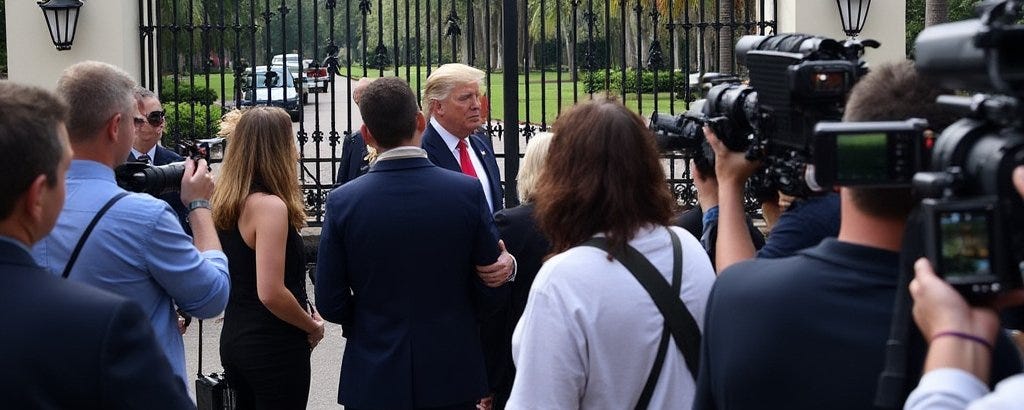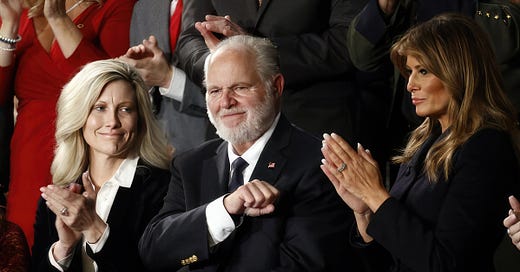

Discover more from @amuse
Panic at Mar-a-Lago: How the Fake Press Pool Fueled Global Fear Until X Set the Record Straight
The establishment of a presidential press pool was once a hallmark of transparency, an assurance to the American people that, no matter where the President was, a fair group of journalists would be there, ready to inform the nation of every development. Yet, today we face a situation where that trusted system has been deeply undermined, as evidenced by the panic triggered by the so-called "unofficial" press pool stationed outside Mar-a-Lago this afternoon. The events of today serve as an alarming reminder of how far the mainstream media has fallen from the role of a responsible communicator to that of a hapless panic-monger. And, simultaneously, they underscore why President Trump’s vision of including independent journalists and outlets in the press pool may be not just warranted but essential.
The chaos began this afternoon when two ambulances, several vans, and a helicopter were seen leaving Mar-a-Lago. An overzealous CBS producer, watching from afar, decided to put forth an explosive theory—President Trump had been taken away by an ambulance. The message was sent out into the pool, stoking speculation among mainstream networks about the president's health. "Was he dead? Had he suffered a heart attack? Was this an assassination attempt?" The breathless, barely contained eagerness with which the mainstream media spread these unverified claims is revealing. They were more than happy to shout fire in a crowded theater, and today, the crowded theater was the entire world.
This situation could have been easily avoided if that so-called "press pool" had simply exercised some restraint, some patience, or—most importantly—some journalistic integrity. The reality? President Trump was very much alive, sitting comfortably in a meeting inside Mar-a-Lago, while the motorcade seen leaving belonged to Vice President-elect J.D. Vance. The rush to publish sensationalist headlines was exacerbated by the utter lack of official channels and coordination. In fact, as Steven Cheung, Trump’s incoming White House Communications Director, noted: the mainstream press created their own "fake, unofficial 'pool' because they want to feel important."
This moment underscores a growing reality—**X **has eclipsed traditional media as the source of accurate, up-to-the-minute information. While CBS and other mainstream media outlets were setting the world on edge, independent journalists on X were the first to debunk the misinformation amplifying the truth from officials inside Mar-a-Lago. Dan Scavino Jr., Trump's incoming deputy, immediately took to X to clarify: "I am currently at Mar-a-Lago, and 45-47 is in a meeting... the movements being reported by the unofficial 'pool'... are that of Vice President-elect J.D. Vance's motorcade." Within minutes, independent voices and Community Notes on X corrected the course, whereas the mainstream networks were still tripping over themselves, searching for a nonexistent scoop.
The History of the Presidential Press Pool: From Roosevelt to Today
The incident today also offers an interesting reflection on the historical evolution of the presidential press pool. It wasn’t always this way—the concept of the press pool, after all, began with good intentions. Theodore Roosevelt was the first president to establish regular relationships with journalists, fostering direct communication between the White House and the American people. Franklin D. Roosevelt institutionalized press briefings, holding biweekly conferences that ensured coverage was grounded in firsthand accounts. These presidents recognized the importance of transparency—not for the sake of a headline, but for the sake of democratic legitimacy.
During the post-World War II era, the press pool took on a more structured form, beginning with Dwight D. Eisenhower. The necessity of having a rotating group of journalists who could travel with and report directly on the president was evident—it balanced the logistical challenges of security with the growing demand for media coverage. By the time of John F. Kennedy, the press pool had become an established mechanism, one meant to serve as a conduit between the highest office in the land and the public. Over the decades, with the advent of 24-hour news cycles and increasing scrutiny during administrations such as Bill Clinton's and Ronald Reagan's, the need for an ever-watchful, organized press pool became the norm.
However, today’s debacle shows us that the press pool is broken. The WHCA, which once coordinated pool coverage, has been sidelined, and in its place is a chaotic gaggle of mainstream networks trying to outdo each other for a moment of sensationalism. This has turned what was once a serious journalistic responsibility into an embarrassing frenzy, with major networks relying on unverified iPhone footage and second-hand assumptions. Their priorities seem less about providing the American people with truth and more about scoring cheap points against a president they disdain.
The Need for Independent Voices: Trump’s Vision for the Future
President Trump has spoken about including independent journalists and new media outlets in the press pool when he returns to office, and after today, it is clear why this must happen. Legacy media has long lost the trust of the American people—its coverage tainted by bias, its reporters more interested in making a splash than in representing the truth. The fake press pool’s handling of today’s Mar-a-Lago incident is yet another mark against a mainstream media that has failed its most basic responsibility.
On the other hand, independent journalists, many of whom operate primarily on platforms like X, have proven to be more agile, more transparent, and, crucially, more aligned with the truth. They do not have corporate overlords with a political agenda, nor do they require the validation of the cocktail circuit in Washington, D.C. They are beholden only to their readers and viewers—the people—and it shows in the accuracy and urgency of their work. These journalists are willing to engage directly, answer questions, provide immediate updates, and debunk rumors in real time using tools like Community Notes.
By including independent media in the White House Briefing Room and the presidential press pool, the Trump administration can ensure that news is not filtered through layers of establishment bias. The truth will not be drowned out by sensationalism or lost in a sea of half-truths and assumptions. Instead, it will be broadcast directly, efficiently, and with integrity. Today’s panic over the supposed medical emergency at Mar-a-Lago would never have occurred if those responsible for communicating news to the American public were grounded in facts rather than fantasies.
X is the News Now: The Shift Away from MSM
Today marked an important moment for anyone still placing their faith in the mainstream media. Platforms like X have completely overtaken the old-guard media when it comes to providing accurate, reliable information. While CBS was fueling a global panic, independent voices on X were speaking directly to members of Trump’s team, cutting through the noise and getting the facts straight. It’s an example of precisely why social media platforms are now trusted far more than any legacy network. They provide a platform for immediate, unfiltered communication, unlike the slow, bureaucratic response of old-school media outlets.
This shift is also reflective of a deeper, more fundamental change in how the public consumes news. People no longer want carefully curated narratives delivered by talking heads with obvious biases. They want real-time updates, and they want to hear from the sources directly—not via a game of media telephone. In today’s digital age, where every smartphone can record history in real time, the power has shifted away from the elite circles of network newsrooms to the hands of those who simply want to share the truth.
Conclusion: Moving Toward Real Transparency
The events at Mar-a-Lago today served as a reminder of the pressing need for change. The legacy press, once entrusted with holding those in power accountable, now seems more concerned with power plays of its own. As the "unofficial pool" tripped over itself in its desperate bid for a sensational headline, independent journalists did what the mainstream media would not—they provided clarity, honesty, and truth.
President Trump’s commitment to bringing these independent voices into the press pool is a promise of real transparency. It is a commitment to breaking away from the stranglehold of legacy networks, to ensure that the American people receive accurate, timely, and trustworthy information. Today, X showed us what the future of news looks like—a direct, unfiltered line to the truth—and it is time that the White House press pool reflects this new reality.
If you don't already, please follow me on 𝕏 at https://x.com/amuse















